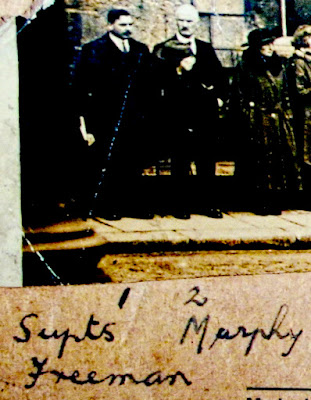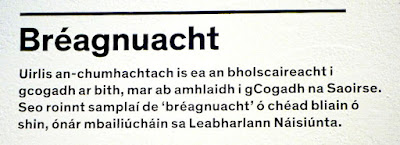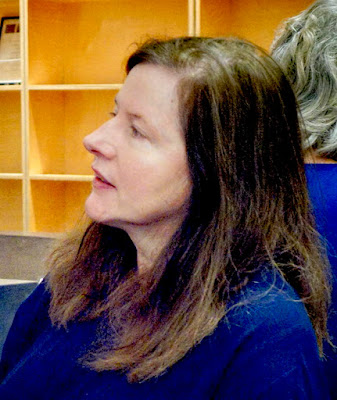A new exhibition has opened in the challenging space at the National Photographic Archive (NPA) in Temple Bar's Meeting House Square.
It is a stunning visual chronicle of the brutality of the War of Independence 1919-21.
Unlike many earlier exhibitions, this one in particular is advertised for its relevance to the school history curriculum. I wish it had been there in my day.
The exhibition is billed as an exploration of key aspects of the Irish War of Independence through 100-year-old photographs from the National Library collections, period newsreels, interactive exhibits, and an accompanying programme of panel discussions, events, and tours.
It is open Mon-Sat: 10am-4.45pm; Sunday 12 noon-4.45pm, and it will be there for the next few months.
First speaker at the launch was Paul Shovlin, Chairman of the NLI Board of Directors. Although the exhibition was being mounted by his own institution he looked suitably overwhelmed and was enthusiastic in his invitation to all present to spread the word and to others to make sure not to miss this wonderful exhibition.
Sandra Collins is the Director of the National Library and, as well as remarking on some aspects of the exhibition and on the NLI's outreach programme, she made a point of individually thanking those who had contributed to this particular exhibition.
When you stand back from it, it's not surprising how many people had an input. Material had to be sourced from the NLI's collections (and elsewhere). Initial decisions had to be made on suitability and relevance with a particular eye to visual impact. Then there was reproduction and design, not just of "panels" but of the whole irregular and challenging exhibition space. And on through to final execution of the project as an integrated whole.
The exhibition was launched by ubiquitous historian, Diarmaid Ferriter. Diarmaid remarked on many aspects and I'll reference just a few.
He underlined the immediacy of imagery as opposed to the purely textual. The feeling that you are there really draws you in to the narrative.
I remember from my own schooldays that there was a distinct lack of the visual in the history curriculum. So much so that I was bowled over by George Morrison's Mise Éire, not just by the newsreels but by the camera roving over still scenes of evictions and of the physical destruction caused by the 1916 Rising.
Diarmaid also paid tribute to the "unencumbered" rank and file of young men who put their lives on the line in the cause. And we tend to remember them as mostly young men.
Happily the mist of invisibility over the vast numbers of women involved is fast being dispersed by modern researchers, and there are so many ordinary and extraordinary women now emerging into the limelight.
It is positively envigourating. And it will need a serious rewrite of our handed-down history.
Diarmaid referred to the Custom House Raid, the burning of the Custom House on 25 May 1921, which you can see behinds him, as something along the lines of an abject failure.
Having read Liz Gillis's excellent book on the subject, and listened to Dev's grandson's take on it, I would prefer to see it as a costly success.
The exhibition team: Nikki and Carol have, yet again, done a great job curating the exhibition. And for those not familiar with the term, it involves a lot of hard work, from planning right through to the "opening night", to borrow a theatrical term and even then put it in quotes, as this exhibition was launched at 11:30 in the morning. Got me out of bed it did.
Breffni is the new Head of Exhibitions, Learning and Programming at NLI.
This is the first thing that caught my eye as I entered the exhibition. It's almost a metre high, so there's no way you'd miss it coming up to a military checkpoint.
But it didn't take me back the full hundred years, only nearly half way to Aughnacloy British Military Checkpoint during the troubles. This was generally manned on the ground by very young, nervous, hair-trigger soldiers, and that often in the dark of night. I take Diarmaid's point about images.
Coming back to the burning of the Custom House, part of the high cost of the operation that I referred to was the life of cousin Peggy's friend, Stephen O'Reilly, and that of his brother Patrick. These were two of the five Volunteers killed in the event. They are named on Yann Goulet's memorial monument in the grounds of the building.
This photo of the two O'Reilly brothers is in the exhibition, though I only spotted it on a second visit on 26/11/2019. Stephen is at bottom right.
This panorama photo stretches right across the wall at the back of the exhibition. It is of a mixed group, civilians and arms-presenting soldiers at Dublin Castle. It is annotated to identify certain figures of interest to IRA Intelligence.
The caption reads: Marked men at Dublin Castle as identified by IRA Intelligence.
The photo was put up on the NLI's crowd-sourced Flickr account and this brought forth information about the location and further details on the Auxiliary John Edward de Casmaker.
Two RIC/DMP Superintendents.
I don't know what, if anything, might have happened to these two guys but Casmaker survived not only the War of Independence but WWII as a flying officer. He died in 1971.
Thanks to Dubliner, Sharon Corbet for referring us (NLI & me) to this information.
Upstairs, the balcony is given over to pictures relating to Terence Mac Swiney, Lord Mayor of Cork, who died on hunger strike in Brixton Prison on 25 October 1920.
These include the cover of a special supplement with the French newspaper Le Petit Journal on 19 September 1920. That day was the 28th day of Mac Swiney's hunger strike. The picture shows Mac Swiney with his confessor Fr. Dominic in Brixton Prison.
As Diarmaid Ferriter told us earlier, it was not known at that time how long a person could survive on hunger strike and 28 days was beyond expectations. Mac Swiney lasted 74 days and Le Petit Journal carried an extensive report on its front page the day following his death.
You can see above the prominence the paper gave to Mac Swiney's death. You can read the full report here.
This partial scan of the paper's front page is not in the exhibition. But I'm dwelling on this newspaper as I am aware that it gave extensive, including pictorial, coverage to Ireland during the War of Independence. I keep coming across illustrations from it in my reading.
In its opening paragraphs, the report tells us that Mac Swiney was surreptitiously fed spoonfuls of gravy (jus de viands) during the final phase of his hunger strike despite his earlier refusal and insistence that this would be a form of violence. Given the earlier force feeding of the suffragettes, it is not clear what might have gone on in earlier phases of this hunger strike.
As Diarmaid also stressed, this was as much a propaganda war as a physical one. The Irish side were very aware of this and had an extensive network of agents spreading their message around the world.
The photo above shows Muriel Mac Swiney, Terence's widow, giving evidence to the American Commission on Conditions in Ireland in Washington DC in December 1920.
I hope you will all help us with our Republic, because that is what my husband lived and died for ... the chief thing is for Ireland to get her freedom.
There is a panel on fake news, including false attribution of photos by the British. This brings home to us that there is nothing new under the sun even if the name changes down the years.
The exhibition is effectively bilingual, and I'd like to use this item to comment more generally on the place of the Irish language in exhibitions by public bodies.
My feeling is that this has become a box ticking exercise in response to the demands of the Irish language lobby. In a nation bereft of monoglot Irish speakers, we have to ask ourselves what exactly is the value added by this practice.
Sure, it remind people, including foreign visitors, that the Irish language still exists, more or less. But beyond that, literal transcriptions of the English text add nothing to the exhibition and presumably involve an additional cost, however small.
If the obligation to present bilingually is to continue it is time for it to add value. I recently came across an example of this, however limited, at an exhibition on Jacob's biscuits in Pearse St. library. There the Irish versions of the English language headings conveyed the meaning but with slant that conveyed something extra.
Why then, if there is to be Irish text, not let it be independent of the English. There are many occasions when Irish speakers will have a different slant on things and will be engaged by different resonances. This might even lead to people becoming curious and learning a bit of it.
Nuff said.
The exhibition also showed some very interesting newsreels from the period.
What you see above is not the result of an eviction in the West of Ireland. This is the sack of Balbriggan:
On Monday 21 September 1920 during the night the Black and Tans sacked the town of Balbriggan in County Dublin, Ireland. The sacking was revenge for the killing of District Inspector Burke and his brother Sergeant Burke, who were shot dead by the IRA while in Smyth’s pub, Balbriggan earlier in the day.
Source
There is also newsreel footage of internment camps on the island of Ireland. The internees here are clearly claiming POW (or political) status though most will probably not have been caught on the field of battle.
The Soldier in the Stairwell is an imaginative addition to the use of the exhibition space - not an inch wasted. To add to the fun, he disintegrates as you mount the stairs.
Not forgetting the women, these members of Cumann na mBan are assembled outside Mountjoy Prison on spiritual combat duty on the day of an execution.
I said this was a challenging exhibition space, but when you get it right the effect can be dramatic, as with the Cumann na mBan women on the outside of the balcony wall.
The curators are, by now, well up to speed on the best use of the space, though there's always room for little surprises, like the soldier on the stairwell.
So it's on to people, and I'll let you have fun figuring out who they are.
And before I was formally ejected, I managed to shoot the photographer.
Don't forget, the door will remain open for the next few months.
Some previous exhibitions at the NPA
A Modern Eye
From Ballots to Bullets
Photo Detectives
































No comments:
Post a Comment
Bona fide comments only. Spamming, Trolling, or commercial advertising will not be accepted.